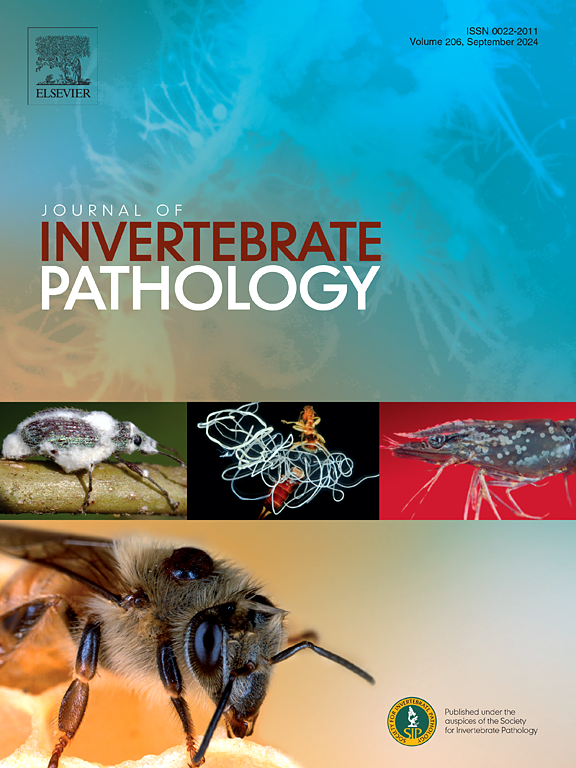Whole genome sequencing reveals recA gene recombination, virulence factors, antibiotic resistance, and emergence of clonal complexes in Vibrio parahaemolyticus associated with acute hepatopancreatic necrosis disease (AHPND) in shrimp
IF 2.4
3区 生物学
Q1 ZOOLOGY
引用次数: 0
Abstract
The AHPN disease, caused by Vibrio parahaemolyticus, is a critical threat to global shrimp aquaculture. In this study, we sequenced and analyzed 5 AHPND-associated V. parahaemolyticus genomes, referred to as CGVP strains (CGVP3, CGVP8, CGVP10, CGVP11, and CGVP18) that were isolated during the 2016 disease outbreak in Korea. These genomes, averaging ∼ 5.3 Mbp, consist of two circular chromosomes (3.3–3.4 Mbp and 1.8–2.0 Mbp) and a 69 kbp plasmid carrying pirABvp toxin genes. Within the genomes, a unique 20.6 kbp insertion in the recA gene, characterized by a lower GC content and 15 open reading frames (ORF), was identified, suggesting a novel genetic recombination event. The phylogenetic and population analyses assigned these genomes to a clonal complex (CC) named CC 917, which exhibits high intra-complex similarity (1–826 SNPs and 99.62–99.98 % ANI) but diverges significantly from strains outside this complex (>20,000 SNPs, <98.09 % ANI). Comparative plasmid analysis revealed high ANI (≥99.86 %) among CC 917 plasmids despite its differences in phylogenetic clustering. Antibiotic resistance profiling identified conserved resistance genes for tetracyclines, beta-lactams, and fluoroquinolones in the CC 917. Virulence factor analysis highlighted diverse profiles for adherence, antiphagocytosis, and chemotaxis genes, while prophage analysis revealed distinct insertions among 5 V. parahaemolyticus genomes in the CC 917. The findings of this study highlight the emergence of AHPND-causing CCs in Korea and the genetic recombination in recA gene, advancing our understanding of the epidemiology, virulence mechanisms, and resistance patterns of this pathogen. This knowledge contributes to improved strategies for controlling AHPND outbreaks and mitigating impacts on shrimp aquaculture.
全基因组测序揭示了虾急性肝胰腺坏死病(AHPND)相关的副溶血性弧菌中recA基因重组、毒力因子、抗生素耐药性和克隆复合物的出现
由副溶血性弧菌引起的AHPN疾病对全球虾类养殖业构成严重威胁。在这项研究中,我们对2016年韩国疾病暴发期间分离的5个与ahpnd相关的副溶血性弧菌基因组进行了测序和分析,称为CGVP菌株(CGVP3、CGVP8、CGVP10、CGVP11和CGVP18)。这些基因组平均约5.3 Mbp,由两条圆形染色体(3.3-3.4 Mbp和1.8-2.0 Mbp)和一个携带pirABvp毒素基因的69 kbp质粒组成。在基因组中,发现了一个独特的20.6 kbp的recA基因插入,其特征是GC含量较低和15个开放阅读框(ORF),表明存在新的遗传重组事件。系统发育和群体分析将这些基因组归属于一个名为CC 917的克隆复合体(CC),该复合体具有较高的复合体内相似性(1-826个snp, 99.62 - 99.98% ANI),但与该复合体外的菌株(20,000个snp, 98.09% ANI)差异显著。质粒比较分析显示,尽管CC 917质粒在系统发育聚类上存在差异,但其ANI均较高(≥99.86%)。抗生素耐药性分析鉴定出CC 917中四环素类、β -内酰胺类和氟喹诺酮类药物的保守耐药基因。毒力因子分析强调了粘附、抗吞噬和趋化基因的多样性,而前噬菌体分析显示了CC 917中5个副溶血性弧菌基因组中不同的插入。本研究结果强调了韩国出现的引起ahpnd的cc和recA基因的基因重组,促进了我们对该病原体的流行病学、毒力机制和耐药模式的理解。这一知识有助于改进控制AHPND暴发和减轻对虾养殖影响的战略。
本文章由计算机程序翻译,如有差异,请以英文原文为准。
求助全文
约1分钟内获得全文
求助全文
来源期刊
CiteScore
6.10
自引率
5.90%
发文量
94
审稿时长
1 months
期刊介绍:
The Journal of Invertebrate Pathology presents original research articles and notes on the induction and pathogenesis of diseases of invertebrates, including the suppression of diseases in beneficial species, and the use of diseases in controlling undesirable species. In addition, the journal publishes the results of physiological, morphological, genetic, immunological and ecological studies as related to the etiologic agents of diseases of invertebrates.
The Journal of Invertebrate Pathology is the adopted journal of the Society for Invertebrate Pathology, and is available to SIP members at a special reduced price.

 求助内容:
求助内容: 应助结果提醒方式:
应助结果提醒方式:


